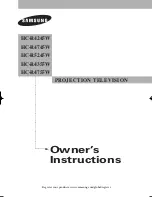
Time
t1Use
: Selection of time characteristic (definite or inverse) for
t1
.
t1
: Time delay for the initial (first) raise/lower command.
t2Use
: Selection of time characteristic (definite or inverse) for
t2
.
t2
: Time delay for consecutive raise/lower commands. In the circulating current
method, the second, third, etc. commands are all executed with time delay
t2
independently of which transformer in the parallel group that is tapping. In the
master-follower method with the follow tap option, the master is executing the
second, third, etc. commands with time delay
t2
. The followers on the other hand
read the master’s tap position, and adapt to that with the additional time delay
given by the setting
tAutoMSF
and set individually for each follower.
tMin
: The minimum operate time when inverse time characteristic is used (see
, figure
).
Line voltage drop compensation (LDC)
OpertionLDC
: Sets the line voltage drop compensation function
On
/
Off
.
OperCapaLDC
: This setting, if set
On
, will permit the load point voltage to be
greater than the busbar voltage when line voltage drop compensation is used. That
situation can be caused by a capacitive load. When the line voltage drop
compensation function is used for parallel control with the reverse reactance
method, then
OperCapaLDC
must always be set
On
.
Rline
and
Xline
: For line voltage drop compensation, these settings give the line
resistance and reactance from the station busbar to the load point. The settings for
Rline
and
Xline
are given in primary system ohms. If more than one line is
connected to the LV busbar, equivalent
Rline
and
Xline
values should be calculated
and given as settings.
When the line voltage drop compensation function is used for parallel control with
the reverse reactance method, then the compensated voltage which is designated
“load point voltage” U
L
is effectively an increase in voltage up into the
transformer. To achieve this voltage increase,
Xline
must be negative. The
sensitivity of the parallel voltage regulation is given by the magnitude of
Rline
and
Xline
settings, with
Rline
being important in order to get a correct control of the
busbar voltage. This can be realized in the following way. Figure
vector diagram for a transformer controlled in a parallel group with the reverse
reactance method and with no circulation (for example, assume two equal
transformers on the same tap position). The load current lags the busbar voltage U
B
with the power factor
j
and the argument of the impedance
Rline
and
Xline
is
designated
j
1.
1MRK 504 169-UEN A
Section 11
Control
Transformer protection RET650 2.2 IEC
227
Application manual
Summary of Contents for ret650
Page 1: ...RELION 650 SERIES Transformer protection RET650 Version 2 2 Application manual...
Page 2: ......
Page 28: ...22...
Page 38: ...32...
Page 42: ...36...
Page 80: ...74...
Page 168: ...162...
Page 174: ...168...
Page 250: ...244...
Page 346: ...340...
Page 366: ...360...
Page 390: ...384...
Page 391: ...385...
















































